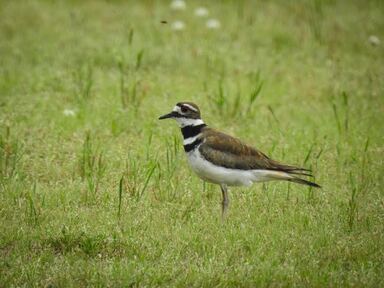 Killdeer; Credit: Deanne Lawrence Killdeer; Credit: Deanne Lawrence Sycamore Grove Farm, Madison County Carl Linnaeus gave the Killdeer its scientific name - Charadrius vociferus - in the 10th edition of his Systema Naturae. Its common name comes from its shrill, two-syllable call: a shrill wailing “kill-deer” that is a distinctive way to identify it, even when it’s not in sight. Other 18th century naturalists had additional names for the killdeer, including “chattering plover” and “noisy plover," given it is in the plover family. Plovers are normally found near bodies of water: the ocean, lakes, and rivers. Killdeer can be found near water as well – but they are equally as common to pastures, lawns, golf courses, athletic fields, parking lots and even rooftops and airports! We have Killdeer on our farm all year around. We see them primarily on the perimeter between our lawn and our hay field. They are very active when the hay is cut, as it stirs up lots of insects! The Killdeer has a distinctive behavior used to protect its nest, called the “broken wing act”. It flutters along the ground in a show of injury, luring intruders away from its nest. This is an important behavior as the Killdeer’s nest is on the ground in an open area, providing the adults good visibility during incubation. Another behavior that has been observed in pastures is the Killdeer fluffing up its feathers to repel cows and horses from stepping on their nests.
The adult Killdeers sometime lines the nest with pebbles, grass, twigs or other bits of debris. The female Killdeer lays between 3-5 eggs and both male and female share incubation, which lasts between 24-28 days. The adults may soak their belly feathers in water to help cool the eggs in hot climates. The young leave the nest shortly after hatching. While the parents tend to them until they can fly, the young birds feed themselves. They are able to fly after about 25 days. Killdeer are mainly insect eaters. They search out beetles, caterpillars, grasshoppers, as well as spiders, earthworms, crayfish and snails. They will forage at night when the moon is full or close to full – both because of increased insect abundance and reduced predation during the night. You can sometimes hear them calling to each other on a moonlit night. Most of Virginia is warm enough for the Killdeer to stay here year round. Their main threat is pesticide poisoning since they forage on lawns and other open spaces that are often sprayed with toxins. These same pesticides also kill their main food source – insects. So avoid using pesticides and leave the bugs for the birds! Happy birding! Charlene
0 Comments
Your comment will be posted after it is approved.
Leave a Reply. |
Have a blog or blog idea?
Let us know (click) Other Blogs
VA Native Plant Society - click Brenda Clement Jones - click John Muir Laws' Blog - click Megan's Nature Nook - click Categories
All
Archives
September 2023
Blog Administrator:
Kathleen A. VMN since 2018 |
